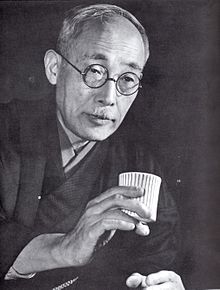|
Yukihiko Yasuda
Yukihiko Yasuda (安田 靫彦, Yasuda Yukihiko, 16 February 1884 – 29 April 1978) was the pseudonym of a major figure in Taishō and early Shōwa period Japanese painting, and is regarded as one of the founders of the Japanese painting technique of nihonga.[1][2] His real name was Yasuda Shinzaburō. BiographyHe was born in Nihonbashi, Tokyo, as the fourth son of a Japanese restaurant owner. He initially studied Tosa school painting at the Tōkyō Bijutsu Gakkō (the predecessor to the Tokyo National University of Fine Arts and Music), under Kobori Tomoto. While in school, his talent was recognized by Okakura Kakuzō who sent him to Nara to study classical paintings in the Yamato-e style. While in Nara, he first viewed the ancient murals on the walls of the Kondo chapel of the Buddhist temple of Hōryū-ji, and this was to have a deep impact on his future style of painting. From 1914, Yasuda assisted Yokoyama Taikan in re-establishing the Japan Fine Arts Academy (Nihon Bijutsuin). From 1944 to 1951, he taught as a professor at the Tokyo National University of Fine Arts and Music. In 1948, he was awarded the Order of Culture by the Japanese government, and was appointed a member of the Japan Art Academy. In the post-war period, he assisted Maeda Seison on restoration and preservation work on the murals of Hōryū-ji. Yasuda was known primarily for his paintings on historical themes, and occasionally for portraiture or bird-and-flower paintings. One of his principal disciples was noted Nihonga painter Yuki Ogura. Important worksYasuda's works have been selected as the subject of commemorative postage stamps three times by the Japanese post office:
References
|
||||||||||||||||||
